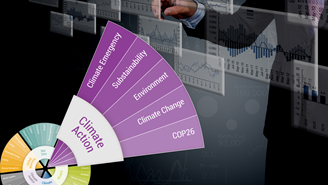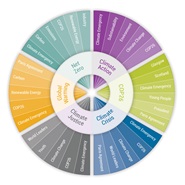COP26—the 2021 United Nations Climate Change Conference—took place from October 31 to November 12 in Glasgow, Scotland. World leaders met to finalize the rules needed for the Paris Agreement and resolve issues from the last conference.
We invite you to access spotlight content related to the COP26 goals. Discover emerging climate action themes that can address the urgency of climate change and how the industry identifies risks and creates opportunities for a sustainable economy in the long term. Find sustainable investing insight related to carbon, greenhouse gases, water and more.
Reach out to our client advisory team to learn more.
Latest Insights from Sustainalytics
For Investors with Ambitions to Lead on Climate Action Post COP26
In the weeks following COP26, investors in the UK and worldwide face a myriad of upcoming climate-related regulations heading towards the implementation phase. In addition, major global coalitions such as the Glasgow Financial Alliance for Net Zero have sprung up to attempt to accelerate decarbonization via targeted investment.
COP 26: A Spotlight on Emerging Climate Action Themes for Investors
Reactions to the COP26 Conference and the resulting Glasgow Climate Pact have predictably run the gamut from claims of greenwashing to the celebration of progress in the fight against climate change. Ultimately, any judgement on COP26 may be premature, as the success of the conference will best be measured in time by the extent to which commitments made are put into motion. While we wait to see the concrete actions that materialize, the past two weeks have underscored the importance of several themes that will garner increasing attention and should be considered by sustainable investors.
COP26 Blue Zone Session Hosted by Sustainalytics.
Adaptation and resilience in urban water: Lessons from practice
Kata Molnar, Thematic Water Expert at Sustainalytics examines discusses the role of various stakeholders in creating appropriate disclosure frameworks and standards for water.
Morningstar Sustainability Insights
COP26 Goals
The Impact and Cost of Air Pollution: U.S. Petroleum Refineries
Investors can examine to what extent petroleum refiners manage their Non-GHG Air Emissions and assess the quality of a company's programs to reduce air pollutants. For instance, examining all the petroleum refiners assessed by Sustainalytics, we observe that only 3% have a strong program to manage non-greenhouse gas emissions.
Impact of Climate Change and Extreme Weather on Essential Services
Utilities have found themselves in the literal and metaphorical eye of the storm over the last year as hurricanes, floods and wildfires of increasing frequency and strength have wreaked damage on their assets. In late August, Storm Ida made landfall in Louisiana, USA and devastated the power grid lines. Entergy, the utility operating in Louisiana, supplying most of New Orleans, restored 90% of the supply only by mid-September, with 87,000 customers still without power.
Related Products

ESG Risk Ratings
Take a coherent and consistent approach to assessing financially material ESG risks.
Learn More
Climate Solutions
Our flagship Climate Solutions assesses the degree to which companies’ enterprise value is at risk, driven by society’s transition to a low-carbon economy.
Learn More
Material Risk Engagement
A proactive engagement with companies with the greatest unmanaged financially-material ESG risks.
Learn MoreBiodiversity: A Crisis Equaling, Possibly Exceeding, Climate Change
According to the UN’s Convention on Biological Diversity the main drivers of biodiversity loss are habitat loss and degradation, climate change, pollution, over-exploitation, and invasive species. Habitat loss is directly linked to the conversion of natural ecosystems to agricultural lands and unsustainable use of water resources.
Related Products

Impact Solutions
Manage and report on the social and environmental impact of your portfolio
Learn More
Thematic Engagement
A proactive collaborative engagement program that focuses on ESG topics aligned to the SDGs, such as Climate Change and Human Capital.
Learn More
Impact Metrics
Impact Metrics is a broad set of company-level metrics that provide measures of environmental and social outcomes.
Learn MoreRelated Products

Sustainable Banking Insights
Helping leading financial institutions build their sustainable banking, lending and finance frameworks.
Learn More
Second-Party Opinions
Helping issuers bring credible green, social and sustainability bonds to market.
Learn More.png?sfvrsn=5caebe45_0)
Supply Chain Solutions
Helping firms asses the overall sustainability of the organizations they work with, from customers to suppliers to partners.
Learn MoreWe can only rise to the challenges of the climate crisis by working together.
For investors and companies to move the needle on climate action, market participants across the value chain rely on
industry-renowned ESG research, ratings, and data. The team at Sustainalytics is steadfast in its commitment to support
clients and the industry with comprehensive solutions, consistent outcomes, and timely innovation.
.png?Status=Master&sfvrsn=b8139e6a_1)
Principal Adverse Impact (PAI) is a key concept in the EU’s Sustainable Finance Disclosure Regulation (SFDR), one of the EU Action Plan on Sustainable Finance’s landmark regulations. PAI is defined as “Negative, material or likely to be material effects on sustainability factors that are caused, compounded by or directly linked to investment decisions and advice performed by the legal entity.”* In the SFDR, there are both narrative and quantitative disclosure requirements for financial institutions around PAI.
As part of the SFDR level 1 regulation that came into force last March, financial market participants are required to make a statement of how they incorporate Principal Adverse Impact in their investment decision process.ii This is a narrative disclosure in the form of a statement, good examples include Robeco’s statement and Nordea’s PAI statement. A similar policy disclosure is required for financial products by the end of 2022.
By June 2023, financial market participants are requirediii to report on a set of Principal Adverse Impact indicators, aggregated at entity level across its investments in a given period. These PAI indicators are essentially a set of environmental, social and governance indicators and metrics, ranging from carbon emissions, water emissions, biodiversity impacts, social violations, and gender parity on the board. The regulatory technical standards provide a table with mandatory indicators, and two tables with voluntary indicators of which a financial undertaking needs to pick one of each. PAI indicators were established for corporate, sovereign, and real estate holdings. There is no requirement to report on PAI indicators on fund/portfolio/financial product level in the regulation (but as mentioned above, a narrative disclosure is required for products).
The PAIs are a comprehensive list; however, the definitions are not always clear and may not always lead to the desired outcome, which is to provide transparency on adverse impacts to the end investor. The list is long, and much of the data will be hard to grasp or benchmark for a non-ESG specialist (how do you compare absolute carbon emission figures between two entities of entirely different sizes? What level of hazardous waste emissions is acceptable?). Furthermore, as EUROSIF also pointed out, some of the proposed definitions and calculations would ideally be improved as they are incorrect or don’t make a lot of sense. In the EU’s new sustainable finance strategy, reviewing these definitions is foreseen for later in 2022, which seems to recognize that their design is not flawless.
Delay to Level 2 Regulation may also impact PAI reporting
While the SFDR level 1 regulation took effect in March 2021, the level 2 regulation, the one that specifies technical standards for implementation, was further delayed recently to June 2022 (see our previous blog for more information on this). Reporting on Principal Adverse Impact indicators (PAIs) is also part of the level 2 regulation.i We assume that this reporting, due in June 2023, is also impacted by this delay; however, ‘how’ is not yet clear.
Momentum for PAI data very strong
Despite the shifting timelines, we observe that the market momentum around PAIs is not diminishing, quite the contrary. Investors in the scope of the regulation are using the fourth quarter of this year to get acquainted with PAI data and set up their systems. Most investors we speak with want to be prepared in time to be able to monitor PAIs throughout 2022 and adjust their portfolios to boost their PAIs (or rather mitigate the downside, as these are adverse impact indicators). This means that PAIs may significantly impact stock selection and portfolio construction by fund managers keen to have ‘good’ PAI scores.
Principal Adverse Impact Indicators to have substantial impact
PAIs may have a larger impact on portfolio compositions than the EU Taxonomyiv in the short- to medium-term. Taxonomy alignment figuresv are expected to be low for some years since the availability of Paris-aligned real-world investment opportunities is still very limited and the Taxonomy itself is not yet fully developed. The market is aware of this fact, and it seems unlikely that the Taxonomy will strongly influence portfolio compositions in the short term, except those explicitly seeking high alignment scores. PAIs, however, present a relatively straightforward (though far from flawless) set of indicators and metrics on which to base stock selection and fund comparison. In looking to improve or optimize their PAI scores, fund managers may rank investee companies based on PAIs, engage those that don’t rank well, and even divest (as can be read in for example, Nordea’s PAI statement mentioned earlier).
Besides an impact on stock selection, it is conceivable that distributors and financial advisors will similarly rank funds based on PAIs or require funds’ PAIs to meet certain thresholds. While the regulation doesn’t require funds to publish their PAIs, we observe in the market that distributors and financial advisors will likely require fund managers to provide them, and we see fund managers already preparing for this. And while the regulation doesn’t set limits, standards or benchmarks for PAIs – e.g., the SFDR does not specify what constitutes ‘high’ or ‘too high’ for carbon emissions or the number of social violations, for instance. However, the market will inevitably start comparing and benchmarking PAIs as soon as reporting commences.
Partner with Sustainalytics and Morningstar for EU Action planning
The combined expertise of Morningstar and Sustainalytics makes serves financial professionals looking for the data coverage, trustworthy research, and flexible reporting capabilities they need to respond to the regulatory demands of the EU Action Plan.
We have recently expanded our SFDR PAI data package covering the corporate and sovereign PAI indicators. Holistically approaching SFDR, clients have access to a full suite of ESG solutions across the investment value chain. Beyond PAI indicator data, we have a broad suite of ESG data, research and services that can support compliance with key aspects of the SFDR:
- ESG research on sustainability risks with supporting screening tools can assist with the policy statements on integrating sustainability risks in investment decisions and risk management.
- Research on corporate governance, a foundation for the definition of ‘sustainable investment’ in SFDR.
- ESG data and metrics for reporting on the attainment of ESG characteristics of article 8 products or the sustainable investment objectives of article 9 products.
- Engagement Services, an important way to take action related to principle adverse sustainability impacts.
- Global Standards Screening and EU Taxonomy Solution to support the ‘do no significant harm’ principle and the requirement to disclose which international standards and norms are adhered to.
- Morningstar ESG indexes can support the attainment of environmental or social characteristics or objectives.
For more information, please reach out through your preferred client service contact, visit our EU Action Plan Resource Center and stay tuned for Sustainalytics’ upcoming on-demand video on EU Action Plan products and solutions.
Sources / Comments:
* Principles Adverse Impact indicators are the predefined list of ESG indicators and metrics (such as carbon emissions, wastewater emissions, social violations, etc.) that are considered to always have a negative impact.
i https://www.esma.europa.eu/press-news/esma-news/
ii Or explain why the entity does not consider adverse impacts of investment decisions on sustainability factors and whether and when they intend to do so.
iii Those financial market participants who take into account principal adverse impact and therefore also have the required narrative statement.
iv The EU’s classification system for environmentally sustainable business activities.
v The percentage of revenues, CAPEX or OPEX associated with business activities that meet all the Taxonomy’s criteria.
Connect with us to discover Sustainalytics' ESG Solutions
Investor Opportunities
Our core research and ratings solutions have enabled the world’s leading institutional investors to identify, understand, and manage ESG-driven risks and opportunities. As a part of Morningstar, we continue to accelerate our efforts to bring meaningful ESG insights to investors of all types across different asset classes at the company and fund level.
Corporate Opportunities
Sustainalytics’ Corporate Solutions unit works with hundreds of companies and their financial intermediaries to help them consider sustainability in policies, practices, and capital projects.
Confronting the global climate crisis involves diverse perspectives, adaptability, and collaboration. Learn more about how investors use ESG ratings to engage on environmental, social and governance factors.




















